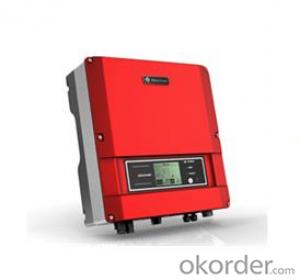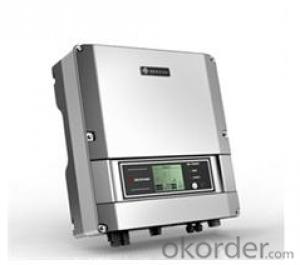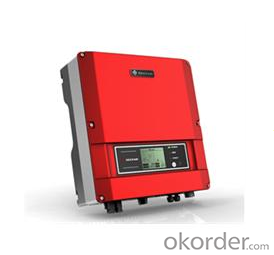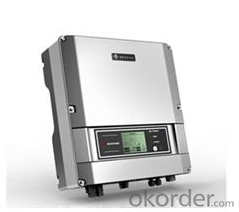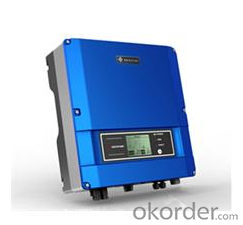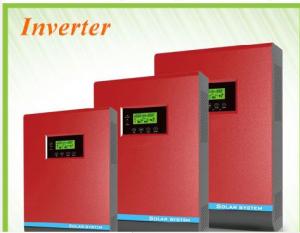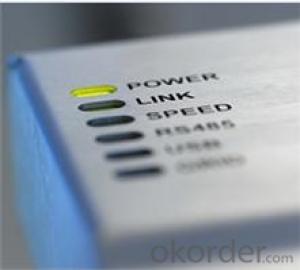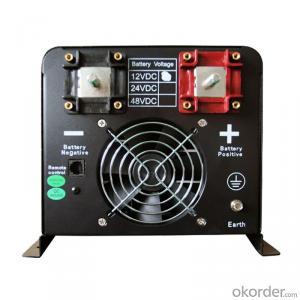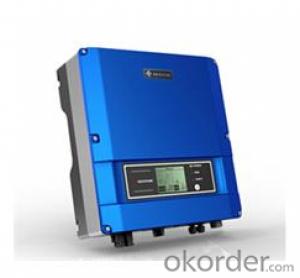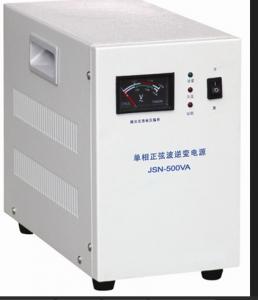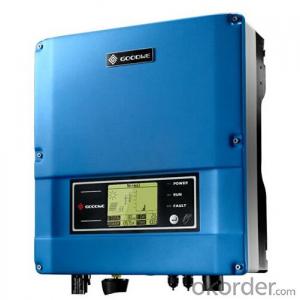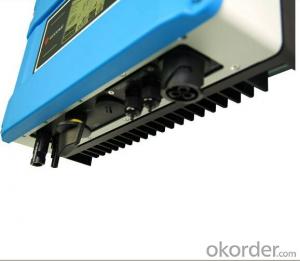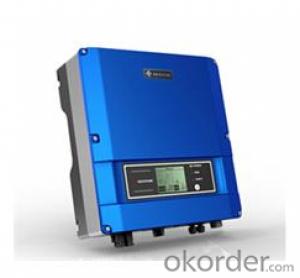Anker Solar Inverter GS4000-SS
- Loading Port:
- Shanghai
- Payment Terms:
- TT OR LC
- Min Order Qty:
- 10 unit
- Supply Capability:
- 100 unit/month
OKorder Service Pledge
OKorder Financial Service
You Might Also Like
GW4000-SS
GW4000-SS photovoltaic inverter is suitable for home rooftop photovoltaic system, designed under modern industrial concept. There are three colors for option with fashionable appearance. According to the test results of PHOTON laboratory, the medium irradiation efficiency is 96.9% and high irradiation efficiency is 97.1%. It has obtained Double A Certificates. It holds a safe lead among the same level of products in the world.
| Input Data | Max.PV-generator power[W] | 4600 |
| Max.DC voltage[V] | 580 | |
| MPPT voltage range[V] | 125~550 | |
| Turn on DC voltage[V] | 125 | |
Max.DC work current[A] | 20 | |
| Number of inputs/MPP trackers | 3/1 | |
| DC connection | MC IV Connector | |
| Self-energy consumption[W] | <5< td=""> | |
| AC Output Data | Nominal AC power[W] | 4000 |
| Max.AC power[W] | 4400 | |
| Max.output current[A] | 22 | |
| Nominal output voltage range | According to VDE 0126-1-1/AI, RD1663, ENEL, G83,G59,SAA | |
| AC grid frequency | According to VDE 0126-1-1/AI, RD1663, ENEL, G83,G59,SAA | |
| THDi | 〈1% | |
| Power factor | ~1 (Norminal power) | |
| AC connection | Single phase | |
| Efficiency | Max.efficiency | 97.8% |
| European efficiency | 97.4% | |
| MPPT adaptation efficiency | >99.5% | |
| Safty Equipment | Leakage current monitoring | Integrated |
| DC switch disconnector | Optional | |
| Islanding protection | AFD | |
| Grid monitoring | According to VDE 0126-1-1/AI,AS4777.1/2/3, RD1663, ENEL ,G83,G59-2 | |
| Normative Reference | EMC compliance | EN 61000-6-1,EN 61000-6-2, EN 61000-6-3,EN 61000-6-4 |
| Safety compliance | According to IEC 62109-1,AS3100 | |
| General Data | Dimensions(W*H*D) [mm] | 390*417*142 |
| Net weight [kg] | 18 | |
| Housing | For outdoor and indoor | |
| Mounting information | Wall mounting | |
| Operating temperature range | -20~60℃(up 45℃ derating) | |
| Relative humidity | 0 ~ 95% | |
| Site altitude[m] | 2000 | |
| IP proection class | IP65 | |
| Topology | Transformerless | |
| Cooling | Nature convection | |
| Noise level[dB] | 〈25 | |
| Display | 4" LCD | |
| Communication | USB2.0;RS485(Wireless/Bluetooth optional) | |
| Standard warranty[years] | 5/10(optional) |
- Q: Can a solar inverter be used in a mobile or RV application?
- Yes, a solar inverter can be used in a mobile or RV application. A solar inverter converts the direct current (DC) produced by solar panels into alternating current (AC) that can be used to power appliances and devices. This makes it suitable for providing electricity in a mobile or RV setting where solar panels are commonly used to generate power.
- Q: What is the expected lifespan of a solar inverter?
- The expected lifespan of a solar inverter can vary depending on several factors such as the quality of the equipment, usage patterns, and maintenance. On average, a well-maintained solar inverter can last between 10 to 15 years. However, some high-quality inverters have been known to last up to 20 years or more. Regular maintenance and monitoring can help prolong the lifespan of the inverter and ensure optimal performance throughout its lifespan.
- Q: What are the safety considerations when installing a solar inverter?
- Some safety considerations when installing a solar inverter include ensuring proper grounding and electrical connections, following manufacturer's guidelines and instructions, and having a licensed electrician perform the installation. It is also important to be cautious of potential electrical hazards and to handle the inverter with care to avoid any personal injuries.
- Q: What are the communication protocols used in solar inverters?
- Solar inverters commonly use several communication protocols to enable communication with other devices or systems. Some of the most frequently employed communication protocols in solar inverters include: 1. Modbus: Modbus is an extensively utilized communication protocol for industrial devices, including solar inverters. It facilitates the transmission of data between the inverter and other devices, such as monitoring systems or data loggers. Modbus is well-regarded for its simplicity and flexibility, which contribute to its popularity in the solar industry. 2. SunSpec: SunSpec is a communication protocol specifically designed for the solar industry. It establishes a standardized means for solar inverters to communicate with other devices, such as smart meters or monitoring systems. SunSpec supports both wired and wireless communication, allowing for effortless integration of solar inverters into larger energy management systems. 3. CAN bus: CAN (Controller Area Network) bus is a widely employed communication protocol in various industries, including automotive and industrial applications. It is a robust and reliable protocol that enables high-speed communication between devices. Some solar inverters employ CAN bus to communicate with other devices or systems, ensuring a dependable means of data transfer. 4. Ethernet: Ethernet is a prevalent communication protocol in the IT industry and is also utilized in certain solar inverters. By utilizing Ethernet, solar inverters can communicate with other devices or systems over a local area network (LAN) or the internet. Ethernet offers high-speed communication and can accommodate various communication standards, making it a versatile option for solar inverters. It is essential to note that different solar inverter manufacturers may employ different communication protocols or a combination thereof. The selection of a communication protocol depends on factors such as the specific requirements of the system, compatibility with other devices or systems, and the desired level of integration.
- Q: Photovoltaic grid-connected inverter problem
- The first zero line is the AC output. Any AC output of the inverter will have zero line, whether it is isolated or non-isolated. Isolation is the safety of high voltage inverters and regulators. 50KW above the inverter almost with the transformer.
- Q: What certifications should I look for when choosing a solar inverter?
- When choosing a solar inverter, it is important to look for certifications such as UL 1741, which ensures the inverter meets safety and performance standards. Additionally, certifications like IEEE 1547 and IEC 61727 validate the inverter's compliance with grid interconnection requirements.
- Q: What is the role of a voltage regulation feature in a solar inverter?
- The role of a voltage regulation feature in a solar inverter is to ensure that the electricity generated by the solar panels is converted into a stable and consistent voltage suitable for use in homes or businesses. This feature helps to protect electrical appliances and equipment from voltage fluctuations and prevents any potential damage that could occur due to over or under voltage conditions.
- Q: Can a solar inverter work in low light conditions?
- No, a solar inverter cannot work in low light conditions as it relies on sunlight to generate electricity. Low light conditions result in reduced solar energy, which makes it difficult for the inverter to convert it into usable electricity efficiently.
- Q: What is the role of a solar inverter in preventing overloading?
- The role of a solar inverter in preventing overloading is to monitor the flow of electricity from the solar panels and regulate the amount of power being generated and fed into the electrical grid. It ensures that the solar system operates within its capacity and prevents excessive power generation that could lead to overloading and potential damage to the system or the electrical grid.
- Q: Can a solar inverter be used with a grid-interactive system?
- Yes, a solar inverter can be used with a grid-interactive system. In fact, a solar inverter is an essential component of a grid-interactive system as it converts the direct current (DC) electricity generated by solar panels into alternating current (AC) electricity that can be used by household appliances and fed back into the grid when there is excess energy. The inverter also helps manage the flow of electricity between the solar panels, battery storage (if present), and the grid to ensure efficient and reliable power supply.
Send your message to us
Anker Solar Inverter GS4000-SS
- Loading Port:
- Shanghai
- Payment Terms:
- TT OR LC
- Min Order Qty:
- 10 unit
- Supply Capability:
- 100 unit/month
OKorder Service Pledge
OKorder Financial Service
Similar products
Hot products
Hot Searches
Related keywords
